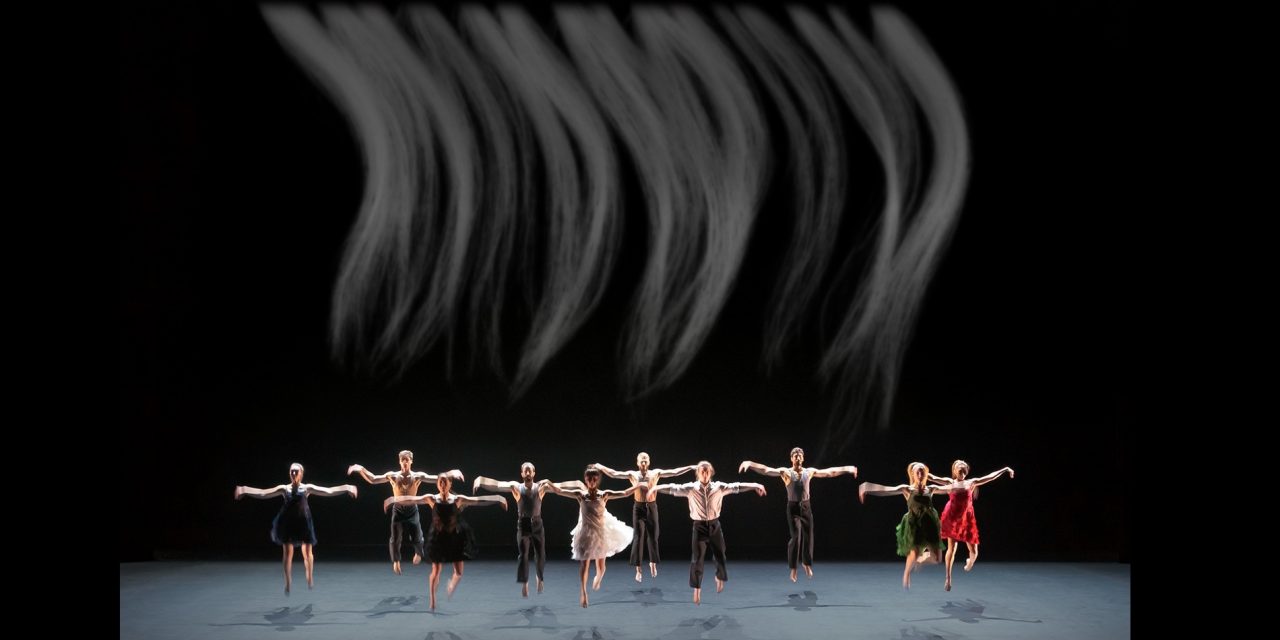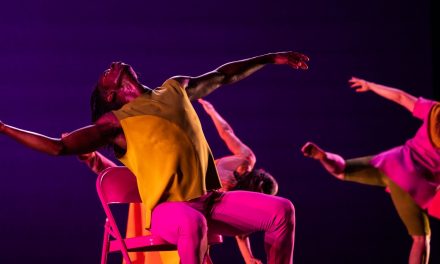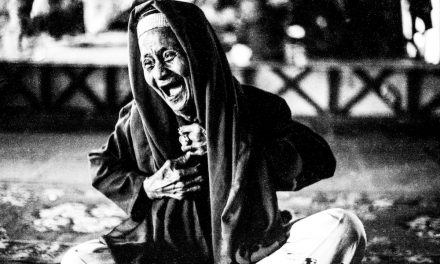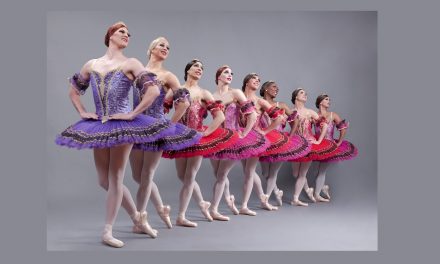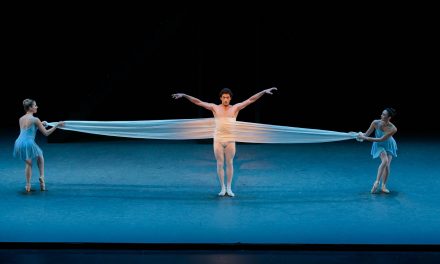Angelin Preljocaj, well noted French dance maker, debuted his Company, Ballet Preljocaj in La Fresque (The Painting on the Wall) at The Soraya, the Valley’s Center for the Performing Arts on April 18, 2019. La Fresque, based on a Chinese tale, entitled The Mural, explores a work of art becoming a place of transcendency. Says, Preljocaj, “the physical being enters the relationship with the picture…[it] seeks to explore the mysterious relations between representation and reality.”
As the lights dim, we are introduced to mesmerizing paint strokes languorously moving on a scrim across the space of the stage, and see two young travelers, Simon Ripert, and Redi Shtylla, strong youthful dancers, first crawling on the darkened stage to the sounds of wind, then rising in frenetic unison utilizing the entire unencumbered space. The dynamic soon turns with the young men using each other’s bodies, traveling over floor, space and air as if there is no difference between them. Ripert and Shtylla’s easy movements are Preljocaj signature choreography in the integration of the body and the emotions. The motion gets more complex as the tale moves on.
To rhythmic drums the young men are then overtaken by three monks shrouded in hoods, pants and slatted skirts (Fran Sanchez, Kelvin Mak Cheuk Hung, and Tommaso Marchignoli). Their powerful presence and technical fierceness, so necessary to be able to work in this demanding company, appears to both guide and entrap the young men. Then the monks fling the travelers, weightless, through the air, lulling the two boys to the temple (as the story goes) and finally to rest near a Fresco painting.
As if in a dream, the set is transformed, “Iris-like,” with Constance Guisset’s minimalist sets and designs, and the exotic costumes by Azzedine Alaia, and becomes a living representation of Idyllic sensuality. The dancers and designers help create mystery, color and movement in tandem with effortlessness. All the elements appear to enhance and work in unity with the performers percussive and languorous movements.
In this scene are five captivating women within the “painting.” “Deborah Casamata, Margaux Coucharriére, the raven-haired Verity Jacobsen, Anna Tatarova and Cecilia Torress Morillo are revealed all seated on a black pedestal. They are intertwined, their long manes of red, blond and raven becoming a kind of waterfall of Hair-ography with their tresses following their bodies as they angle and lift from seated to mid-air as their hair whips over their undulating bodies. They work in tandem and canon, heaving forward and backwards, side to side, smoothing their arms over their long hair, extending the movement and hypnotizing the viewer. Then most unexpectedly, they’re suddenly motionless as if in a Renaissance frieze. This section clearly adds excitement, sensuality, uniqueness and a level of creativity that extends beyond their bodies.
Upon waking from a dream, one of the young men becomes intrigued with the raven-haired Jacobsen who fascinates and enthralls him inside the painting. Her beauty and flowing hair symbolize the youth of an unwed girl, and in the piece he is so taken by her beauty that he is transported into the painting.
This attraction goes beyond their obsession for one another with an energetic and complicated Pas de deux (dance for two), exchanging solos, and eventually joined by the company which morphs into a piece, with masked guests moving in a kind of phantom minuet. There is a sense of years passing.
In a pre-wedding ritual, there is a percussive uniting of the group where the women continuously bound up and down while tying the brides long flowing hair into a chignon, signifying the girl is becoming a married woman. When completed, it becomes the honoring of the couple’s union.
On the wedding night her young husband showers her with deep red roses as they consummate their union and retire in blissful sleep. The young husband’s sleep is interrupted by warriors who banish him from this Fresco world.
When he has escaped from the painting, we see his traveling companion who has looked for him, not for years, but for minutes. After this adventure, they both look back at the Fresco. We see the Madonna-like creature center in the gathering of females. As we look closer, she has no longer long flowing hair in the picture, but a chignon and is wearing a crimson red rose in her hair.
A fantasy, yes, good dance yes! There is no doubt that the company has been carefully chosen and trained in the style, yet when Preljecoj’s innovative technique was originated numerous years ago and until now, it looks as though it is simply competing with itself. Yes, there are others who have copied and extended the technique further. However, there is a déjà vu to the whole evening. Most assuredly the dancers are superb, the choreography difficult, the music mesmerizing, the story simplistic and ancient, yet we are left exhausted and not sure if we need to be searching for a deeper meaning to this legend after the hour and a half of intermission-less attentiveness. Perhaps it is to be respected as a slice of history.
For more information on Ballet Preljocaj, click here.
For more information on The Soraya, the Valley’s Center for the Performing Arts, click here.
Featured image: Ballet Preljocaj in La Fresque – Photo by Constance Guisset Studio

